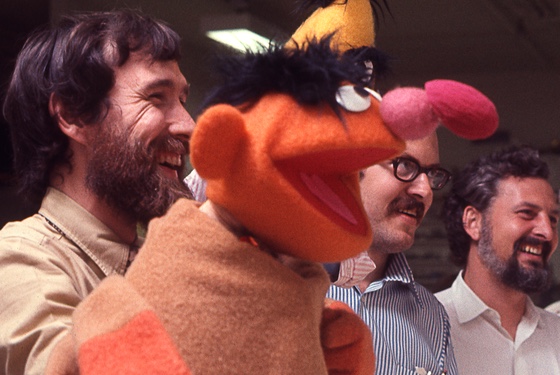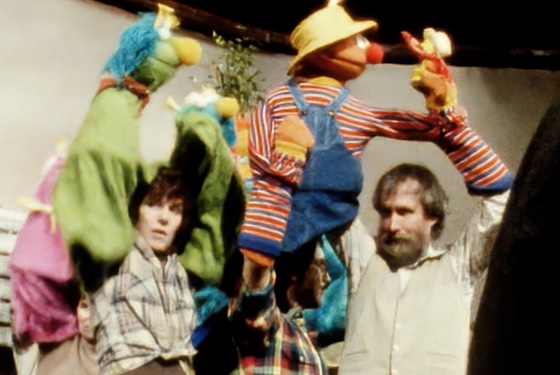It is impossible to overstate the impact and the influence that Sesame Street had on my generation growing up in America. We were so unfathomable that our elders later dubbed us Generation X, but all they had to do was look back to just a bit earlier, to this kiddie TV show that launched in the formative years of the eldest of our cohort.
If we’re snarky, sarcastic, and meta, that ain’t on us. If we’re simultaneously grounded and pragmatic and yet also a bunch of goofballs, that ain’t our fault.
If I bawled my eyes out in aching nostalgia watching the absolutely delightful and informative Street Gang: How We Got to Sesame Street, I am not to blame.

Documentarian Marilyn Agrelo, working from the book Street Gang: The Complete History of Sesame Street by Michael Davis, dives into the formation of this groundbreaking show, which invented educational television with carefully crafted chaos that was like nothing anyone had seen before. A bunch of grownups — including producer Joan Cooney, director Jon Stone, and beyond-legendary puppeteer Jim Henson — were worried about us wee Xers, the original screen-time kids, the first ones to be addicted to a device throwing colorful pictures and irresistible tunes at us. But they figured that if we could sing beer jingles and identify corporate logos from watching TV, we could learn more useful stuff, too.
So they came up with a glorious fictional city street so racially integrated that furry and feathered and felty monsters lived on it, too, among all the black, brown, and white people. (We learn here about, unsurprisingly but enragingly, a place in the South where they didn’t want their kids exposed to such interracial harmony, and so wouldn’t air the show.) They whipped up ticklish mayhem and hilarious anarchy in snappy sketches and cartoons with catchy songs to teach us the alphabet, numbers, and other arcane (to the preschool mind) concepts. They gave us parody singalongs, James Taylor serenading Oscar the Grouch, and a melancholy Kermit the Frog crooning that “It’s Not Easy Being Green.” (Practically half this film is a heartfelt ode to Street songwriter Joe Raposo, a total charmer in vintage footage. There should an entire movie about him.)

I was three months old when Sesame Street debuted in November 1969, and it is a part of my childhood that I cannot disentangle from the rest of it. I was flooded with flashback memories watching this doc, which of course features copious clips from the show. I remember it all, and found myself singing along again, and also sobbing with joy. And sometimes with straight-up sadness. (The death of Mr Hooper! *sob* And I was 13 years old when that happened.) But I also learned a ton of stuff that little me never knew. The Gordon I remember — friends, I did squeal “Gordon!” at the first retro look at him here — was not the first Gordon; they recast him! (My Gordon, a human character, for those unlucky enough not to be familiar with the show, was played by Roscoe Orman, who appears here to look back, as do other cast members. They are all 100-percent marvelous.) Somehow I never realized that Caroll Spinney, who performed Big Bird, also gave life and voice to Oscar the Grouch. I never made the leap to see Henson and Frank Oz (Knives Out, Star Wars: The Last Jedi), who performed lots of Muppets — perhaps most notably as, respectively, Ernie and Bert — as a classic comedy duo akin to Laurel and Hardy… but that case is made easily here.
More reasons to see Street Gang: bloopers and outtakes! Cute Muppets saying things that would never have made it on-air, things that would have scandalized parents (if perhaps not baby Xers). But even the vaguely naughty, slightly adult stuff is as full of sweet, smart, foolish exuberance as everything that ended up in the show. Sesame Street has always been a treasure, and this lovely backgrounder only deepens our appreciation of it. *insert GIF of Kermit waving his arms wildly and yelling “Yayyyy!”*

























I just added the movie to my watch list, but I’d also very much recommend the documentary 50 Years of Sunny Days, about the social impact of the show, which aired on ABC a few weeks back:
https://youtu.be/jrllOQ_sp_8
I knew about the book, but not the documentary. I streamed it with my family as soon as I saw you had posted a review. Like you, many happy tears. Thanks so much.
Random thoughts:
Roscoe Orman was my Gordon too; I knew about the first one, Matt Robinson, but didn’t know about his Black activism and how much of it he brought to the character and the show. (Didn’t know that he invented Roosevelt Franklin either, or the pushback that got that character booted from the show—I wondered where he went!)
Caroll Spinney performing Big Bird and Oscar: yeah, it still blows my mind that he was both. That makes Christmas Eve on Sesame Street even more amazing to watch, as it’s mainly a story about the conflict between Oscar’s cynicism and Big Bird’s innocent hopefulness.
So many good clips! (Including the FIRST “Wanda the Witch,” before Elizabeth Olsen’s version. :-)) It sent me hunting for more clips on YouTube, especially the ones where the muppets just chat with human kids. (“Herry Monster and John John count to 20” is unbelievably adorable.)
I’m so glad Joe Raposo’s music was so heavily featured. This song isn’t by Raposo, but it’s one of my all-time favorites from the show, sung by Olivia (the glorious Alaina Reed Hall) and David (Northern Calloway, whose tragic story is covered in the book but not the film). One take, live singing, no edits, no VFX, just sheer talent and joy.
https://www.youtube.com/watch?v=6eOuR0MjNAI&ab_channel=SPGOALSTV